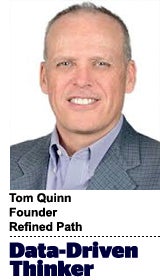 “Data-Driven Thinking” is written by members of the media community and contains fresh ideas on the digital revolution in media.
“Data-Driven Thinking” is written by members of the media community and contains fresh ideas on the digital revolution in media.
Today’s column is written by Tom Quinn, founder at Refined Path.
Customer data platforms (CDPs) have been a hot mar tech category, but they’re often misunderstood.
Some of this comes from competing technologies that claim similar capabilities. There are also more than 50 tech providers claiming to be CDPs, which adds to the confusion.
With this backdrop, it’s no surprise that many organizations don’t know if they need a CDP or are unclear about the best way to buy one.
Start with strategy
I find that there are three primary strategies that CDPs help: marketing, customer engagement and analytics. When planning in these areas, I recommend that companies have someone on their team who understands how customer data platforms can potentially be used.
A common blind spot for organizations is to only consider strategies that can be delivered with their existing data and technologies. For example, if a company has a data management platform (DMP) and limits itself to strategies that the DMP can deliver, it may be missing huge opportunities. When in planning mode, here are four clues that a company may need a CDP:
- Its strategy requires timely omnichannel personalization beyond advertising
- First-party customer data is an important part of its strategy
- Its analytics strategy requires a single customer view
- It needs a platform to support General Data Protection Regulation (GDPR) compliance
Whether they have a CDP or not, companies ought to clearly understand how these platforms can potentially be used to better engage and understand customers. It’s a red flag if customer data platforms are not being discussed as a potential solution.
Designing use cases is critical
So, an organization realizes that it may need a CDP. What’s next?
AdExchanger Daily
Get our editors’ roundup delivered to your inbox every weekday.
Daily Roundup
It must be understood that these platforms are not one-size-fits-all, out-of-the box solutions. Based on its strategies, the organization should design specific use cases.
It may want to engage with CDP vendors to ask for examples of use cases that they are doing for similar clients. But companies also shouldn’t just cherry-pick a platform’s existing use cases – they should design applications that are right for their customers and business needs.
This exercise ought to clarify the data and technology needed. Companies should match this against their existing assets to identify gaps and clarify data and tech requirements.
Some companies have invested in CDP technologies before designing use cases and later discovered that the platform they chose either couldn’t deliver what they needed or that incremental customization was required. Not ideal if they hadn’t planned on the additional time and cost required.
Remember, CDPs are not THE solution; they enable solutions. I can’t emphasize enough that designing great use cases is critical. Even if a company selects the right technology, if they don’t have the right use cases, they will likely not achieve their desired outcomes.
Selecting the right vendor and scope
With clear data and technology requirements, companies are almost ready to engage vendors. But before they do, I would encourage them to take the time to build internal alignment on their vision and approach, especially across marketing, analytics and technology. Then they should select the person(s) who will manage and participate in the vendor review and buying process.
The people leading the initiative should have a clear understanding of the strategy and use cases. They also ought to have the bandwidth to engage with internal stakeholders and external vendors. People with a change-agent mindset is ideal.
They should have executive-level support and access. If they need additional support, it should be given to them. Implementing a CDP at scale is not a one-person job. Companies ought to ensure that their assessment teams understand data, technology and marketing strategy.
When engaging CDP vendors, companies should ensure that vendors can deliver against their requirements. They should ask for demos that prove it. If a company wants something that a vendor has never delivered before, the company ought to request to see a similar customization. It’s a red flag if a company requires integrating and/or activating data sources that the vendor hasn’t previously connected.
Aside from evaluating the CDP technologies, companies must understand who at the vendor they will be working with on data integration. When data is connected for the first time, there are always issues. There may be inconsistencies or gaps that need to be filled. It may take a few months or even up to a year to get the data where the company wants it. To get this process right, organizations should have good working relationships with the vendor contact(s) that they will be working with.
Lastly, companies shouldn’t simply aim for the lowest cost solution. They ought to select the platform that offers the best analytics and activation to achieve their desired outcomes. This is too important to be cutting corners.
Buying and implementing the right CDP requires a strategic approach. Companies will have much greater success if they get their teams aligned and give the people who are leading the initiatives the support that they need to succeed.
Follow Refined Path (@TomAQuinn) and AdExchanger (@adexchanger) on Twitter.












